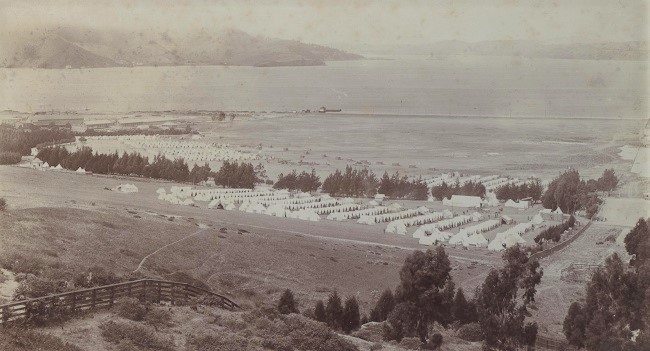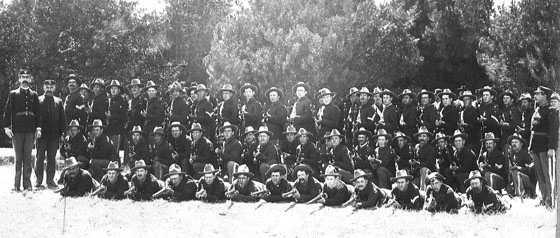


The 1st New York Volunteer Infantry served in Hawaii during its term of service.
Unit History:
With the declaration of war with Spain, Brig. Gen. Robert Shaw Oliver, was ordered create two regiments from the National Guard organizations in his brigade. One regiment was formed from the Tenth, Twelfth, and Seventeenth battalions and the Forty-fourth Separate Company. This group was designated as First Regiment, New York National Guard.
In the re-organization, the following changes were made:
Companies A, B, C and D, of the Tenth Battalion, at Albany, became Companies A, B, C and DThe Forty-forth Separate Company (Walton) became Company E.
The Thirty-third battalion (Walton) became Company F
The Third, Battalion (Oneonta) became Company G
The Twentieth Battalion (Binghamton) became Company H.;
The Twenty-fourth Battalion (Middletown) became Company I.
The Fifteenth Battalion (Poughkeepsie) became Company K
The Fifth battalion (Newburgh) became Company L
The Fourteenth battalion (Kingston) became Company M.
General Thomas H. Barber, the former Inspector-General of the State,
was appointed the regimentís colonel on April 129, 1898. Major Horatio
Potter Stackpole, formerly of the Tenth battalion was appointed
lieutenant colonel.
The companies left their home stations on May 2nd for Camp Black, at Hempstead Plain, on Long Island. The regiment was mustered into the federal service, on May 20, 1898 as the 1st New York Volunteer Infantry. At the time of muster in, the regiment consisted of forty-seven officers and 972 enlisted men.
On June 11, the regiment departed Camp Black, with the exception Company H, which found itself under quarantine for measles. Companies A, B, C, D and F were sent to Fort Wadsworth. Companies E, I, K, L, ad M were sent to Fort Hamilton. Company G and the Headquarters staff were sent to Fort Columbus. Company followed to Fort Columbus later. While in these locations, the regiment was brought up to full strength with the arrival of 301 additional recruits.
In early July, orders arrive for the regiment to be on the move to San Francisco. On July 7, the first leg of the trip was by water to Jersey City. Here the regiment embarked on the Erie Railroad to Chicago. At Chicago, it traveled to Omaha, Nebraska via the Chicago & Northwestern Railroad. This was followed by a leg to Ogden, Utah aboard the Union Pacific, and finally arriving in San Francisco via the Southern Pacific railroad. The whirlwind trip took only a week.. The regiment arrived at Camp Merritt, but was moved the following day to the Presideo, since Camp Merritt was already suffering from a lack of sanitary conditions.
In san Francisco, the men of the First New York found that they were less than halfway to their final destination, which would be Hawaii then still an independent nation, but very friendly to the United States.
On August 5th Companies B, C, H, I, K and the Hospital Corps boarded the transport CHARLES NELSON, steaming for Honolulu, Hawaii the next day. The transport arrived eight days later. The men of the 1st New York established a camp on the race track at, an named it Camp McKinley. It was located about five miles outside of Honolulu.
While first companies were en route, on August 10, Company E and forty-eight men of company D departed for Hawaii aboard the MARIPOSA, arriving a week later, and joining the men of the 1st New York already in Hawaii. Companies F, G and H departed San Francisco for Hawaii on August 18, aboard the ALLIANCE, with a passage lasting nine days. The final group, consisting of the Headquarters, band, and Companies A, B and the remainder of Company D departed on August 27 aboard the transport SCANDIA, arriving in Honolulu on September 3rd.
The latter units encamped near Camp McKinley on the Irwin Track. They were joined at the new camp by the troops who had arrived earlier with the unit again being combined to a single unit.
While the regiment was gradually moving to Hawaii, the fighting of the war had ended. Spain and the U.S. had agreed to an armistice in mid-August.
On November 30, the headquarters, and companies A, B, D I, and L embarked for the return trip to San Francisco aboard the transport AUSTRALIA, arriving on December 6. The following day, Companies C, E, F and G embarked aboard ALMEDA in Honolulu, arriving in San Francisco on December 14.
While these men were en route, the Spanish American War ended on December 10, 1898 with the signing of the Treaty of Paris.
On December 15th, Companies A, B, D, I and L, began their cross-country trek back to New York, arriving on December 22nd, followed in a few days by the remainder of the regiment.
The regiment was mustered out from February 20th to 26th, 1899. At the time of muster out, the regiment consisted of forty-six officers and 1,216 enlisted men. During its term of service, the regiment had twenty-four enlisted men die of disease, and had seventeen more discharged on medical disability. Three men deserted.

Adjutant General of the State of New York, New York in the Spanish American War. (Albany: 1900).
LaBarre, John - Images of 1st New York at San Francisco and the 1st New York, Co. L (also, thanks to James LeBarre)
Statistical Exhibit of Strength of Volunteer Forces Called into Service During the War with Spain; with Losses from All Causes. (Washington: Government Printing Office, 1899).